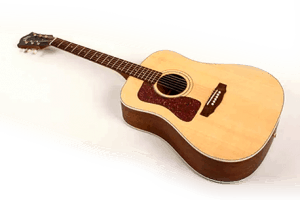
Choosing the right guitar can be challenging, especially with so many options available. The three most common types of guitar are acoustic, classical, and electric. Each type has unique features that influence its sound, playability, and suitability for different musical styles.
The primary difference between acoustic, classical, and electric guitars lies in their strings, construction, and how they produce sound. This guide breaks down the characteristics of each guitar type and provides insights on which one may be best suited for you.
Shape & Size
Acoustic steel string guitars have a hollow body that resonates and naturally amplifies the vibration of their strings. There’s a variety of acoustic guitars in different shapes and sizes including jumbo, dreadnought, orchestra and concert guitars. Common wood types include spruce or mahogany for the top and mahogany, rosewood or maple for the back and sides, all of which influence the guitar’s resonance and tone.
Classical guitars are actually a type of acoustic guitar, but they have some key differences in design. The neck/fingerboard of classical guitars is wider than that of standard acoustics. This wider fingerboard offers more space between the strings, which is ideal for intricate techniques. However, it can also make forming chords and scales more challenging, as it requires your hands to stretch further. For guitarists who are used to an electric guitar or steel string guitar neck and fingerboard, some companies make a fusion model classical guitar designed for these players.
Another notable difference is the absence of fret markers on traditional classical guitars. This can make learning the fretboard more difficult for beginners (however, some makers are now putting them on their guitars on the side of the fingerboard). Finally, the body of classical guitars is usually smaller, and traditional classical guitars lack a pickguard since they are designed to be played with fingers.

Unlike acoustic and classical guitars, electric guitars typically have a solid or semi-hollow body. This is because they don’t rely on an acoustic chamber for their sound projection. Instead, they use magnetic pickups that capture the string’s vibrations and send them to an amplifier. Their solid body helps to reduce any feedback and allows for a wider range of effects. There is such a thing as a hollow-body electric guitar which produces a warm, rich, and resonant sound. Semi-hollow and solid-body guitars were developed to combat amplification feedback issues at higher volumes for some styles of music.
Electric guitars are often made from woods such as ash, alder, mahogany or maple. Their builds are very customisable, with adjustable pickups, tone controls and bridge types that all influence their sound.
Strings
One of the main differences among these types of guitars is the strings they use. Acoustic and electric guitars use steel strings, as opposed to classical guitars, which use nylon. The steel strings on acoustic guitars produce a bright, crisp tone with strong projection. Electric guitar strings are thinner (lighter gauge), but their sound is amplified by magnetic pickups and an amplifier. Steel strings can either be made from plain steel or bronze or can be wrapped over the steel strings to make wound strings.
The nylon strings on classical guitars are thicker, creating a softer, mellow sound. Some believe that the softer feel of nylon strings can be easier for beginners to play with. The treble strings are only made with nylon (plain or rectified) or fluorocarbon while the bass strings are silver-plated, nickel-plated, pure silver, or golden alloy wound.
Note: guitars designed for nylon strings are not designed or built to withstand the higher tension of steel strings.
Sound Production & Playing Style
The bright tone of acoustic guitars makes them ideal for genres like folk, country, rock and pop. They can be played using both strumming and fingerpicking techniques. Because they don’t need an amplifier, acoustic guitars are convenient for casual playing, learning and songwriting.
Nylon string guitars offer warm, smooth tones, making them well-suited for flamenco, Latin, and classical music styles. Their smaller build can make classical/nylon string guitars quieter than steel string acoustics. When performing on a classical guitar players often require a microphone or pickup to amplify their sound.
Electric guitars rely on built-in pickups to produce sound. When a string is plucked or strummed, magnetic pickups beneath it detect the resulting vibrations. The pickups then convert these vibrations into electrical signals, which are then amplified and played through the speakers in your amplifier. One of the great things about electric guitars is their versatility. A single model can be used across a wide range of musical genres including rock, funk, metal, soul, jazz, pop, blues, reggae and more.
While strings are still an important part of the electric guitar sound, other factors can impact tone, including amplifiers, pedals, and the guitar's controls. These all significantly shape the tone. The thinner electric guitar strings require less finger pressure than steel-string acoustics, making them easier on the fingers.
Acoustic guitars aren't necessarily easier to learn than electric guitars. Skills and techniques learnt on one style of guitar are largely transferable to a different style of guitar. Some people find nylon string guitars to be softer on the fingers, whilst others find electric guitars easier as they may be set up with a lower action and lighter string gauge.

Need Help Choosing a Guitar?
Each guitar type has its strengths, and the best choice depends on your musical goals and preferences. Zenith Music offers a wide range of guitars from world-leading brands. Visit our store and speak with one of our expert staff to help you find the guitar that best suits your needs.


